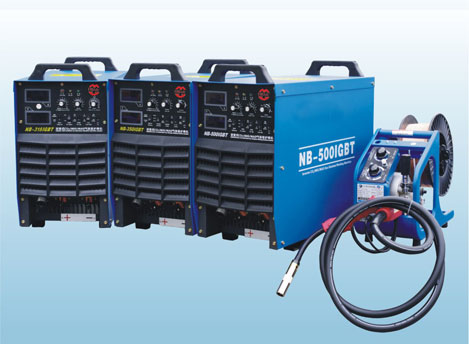The difference between TIG, MIG and MAG welding
1. TIG welding is generally a hand-held welding torch and the other hand-held welding wire, which is suitable for manual welding of small-scale operations and repairs.
2. MIG and MAG, the welding wire is sent out from the welding gun through the automatic wire feeding mechanism, which is suitable for automatic welding, of course, it can also be used manually.
3. The main difference between MIG and MAG lies in the protective gas. The equipment is similar, but the former is generally protected by argon, suitable for welding non-ferrous metals; the latter is generally mixed with carbon dioxide active gas in argon, suitable for welding high-strength steel and high-alloy steel.
4. TIG and MIG are both inert gas shielded welding, commonly known as argon arc welding. The inert gas can be argon or helium, but argon is cheap, so it is commonly used, so inert gas arc welding is generally called argon arc welding.

Comparison of MIG welding and TIG welding
MIG welding (metal inert-gas welding) is an arc welding method that uses a molten electrode and an external gas as the arc medium, and protects the metal droplet, the welding pool, and the high temperature metal in the welding zone. It is called molten electrode gas shielded arc welding. The inert gas (Ar or He) shielded arc welding method with solid core wire is called MIG welding, or MIG welding for short.
In MIG welding, a metal wire is used instead of the tungsten electrode in the welding torch. Others are the same as TIG welding. Therefore, the welding wire is melted by the arc and sent into the welding zone. The electric drive roller feeds the welding wire from the spool into the welding torch as required for welding. The heat source is also a DC arc, but the polarity is exactly the opposite of that used in TIG welding. The shielding gas used is also different. Add 1% oxygen to the argon to improve the stability of the arc. Like TIG welding, it can weld almost all metals, and is especially suitable for welding aluminum and aluminum alloys, copper and copper alloys, and stainless steel. There is almost no oxidation burning loss during the welding process, only a small amount of evaporation loss, and the metallurgical process is relatively simple.
TIG welding (Tungsten Inert Gas Welding), also known as non-melting inert gas tungsten protection welding. TIG welding is the most commonly used welding method whether it is manual welding or automatic welding of 0.5 to 4.0 mm thick stainless steel. The method of adding filler wire with TIG welding is often used for the bottom welding of pressure vessels because the air tightness of TIG welding can reduce the pores of the weld during pressure vessel welding.
The above information is provided by welding torch exporters.






